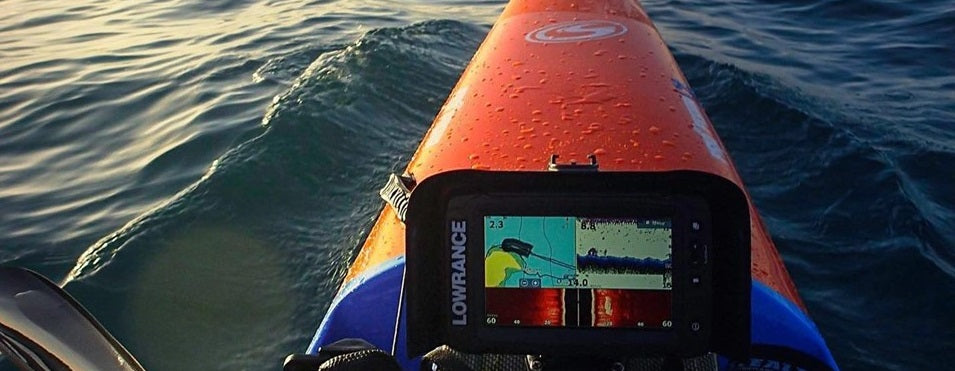
Sounder Choice Part Two: The Options
Main brands and models
Following on from our previous article about a few of the basics to look for, here’s a bit of info on how those basics relate to some of the more commonly used kayak sounders on the market today!
Please note that the rundowns I am about to give are not the be-all and end-all of options out there. This is simply a short rundown on brands and types which are most commonly used by offshore yakkers with as clear a view as I can give on their pros and cons based on their features, feedback from others and my personal experience with each (I have used all of these brands in varying models at some point). It won’t be entirely unbiased and not everyone will agree with everything in here, but there’s definitely good reasoning and a bit of experience from myself and others behind these views so hopefully it will be of some use!
Lowrance
Lowrance has had a long run of different units which suited kayak fishing, from the older elite units all the way up to the current Hook2 4 and 5s. The older models were quite notorious for having very mixed feedback on their durability. Although their plugs had great locking seals and when they were working they had no issues with signal, they were fairly well known for fritzing and dying out of nowhere and having inadequate sealing on their head units. That being said, their support team is well known for being quite fantastic and in most cases replaced those faulty units with minimal fuss.

Jack Dekort's been using his lowrance to keep his rod bent over winter!
The newer hook2 sounders have had, in my opinion, a downgrade on the plugs. They’re a simple pop-in design now and although the rubber seals definitely, well, seal, they’ve got a chance to be knocked out and in my opinion aren’t as trustworthy. Like all of the poor plug options in other brands though, by permanently sealing them into the back of the unit with Sikaflex or packing the plugs with dielectric grease this issue can be overcome.
On the massive plus side, these units are cheap. If you shop around and wait for sales to come along, you can get your hands on a hook2 4inch unit with GPS for around $150 and without GPS for around $120. They don’t have CHIRP, but at that price it’s safe to say that they do the job! The hook2 5 inch units on the other hand are a decent amount pricier, but they do have the options to use better transducers that are capable of side/downscan, as well as chirp which probably make them the most suited sidescanning sounder currently in production to offshore yakking given their small size.

Locking, sealing plugs are a good idea on external mounts
Humminbird
Remember that 798 that I was talking about in the last article? It died. :(
Humminbirds don’t have the best reputation for standing up to being constantly splashed, whether in the surf zone or not. The only real units in their range which I reckon come close to suiting kayaks are currently the piranhamax 4 and the helix 5. Both use the same plugs which don’t seal that well, and most of the people who I know to use them on the yak have had similar experiences to me with their longevity (or lack thereof). That said, if you can keep it in good nick, they do produce a good quality reading which I believe is quite hard to fault. This is why they’re fairly popular amongst boaties from what I gather— if you can keep them dry, they’re highly trustworthy units in terms of what they display.
Another downside for kayakers however, is the price. Their features just don’t quite stack up in my eyes for value when compared with other offerings. When you can get a hook2 4x with a built-in GPS for $150, spending $200 on a sounder with similar or worse durability without a GPS or any other standout features just doesn’t quite make sense. Likewise with the helix 5— both a Lowrance hook2 5 with a Sidescanning transducer and a 7 inch Garmin striker SV are cheaper, and if one of any of these succumbs to the elements you’ll be considerably out of pocket.

Times were good while they lasted, old friend :(
Raymarine
Raymarine are a reasonably new player to the kayak sounder market, having only launched their dragonfly range a few years ago in 2013. Dragonflies come in 4, 5 and 7 inch but are getting trickier to find nowadays. It’s a bit tricky to tell whether or not they’ve been discontinued, but a few stores definitely still carry stock.
Their plugs have a locking style reminiscent of the old Lowrances which works well, their displays are fantastic and the head units are well sealed. They do come with a massive transducer which can be a bit awkward to install through a small hole in a fish hatch wall, but these sounders definitely give great readings and are pretty hard to fault from a construction perspective. Their downsides, however, are price and the fact that in order to flush mount it you’ll need to separately purchase a kit which is especially annoying to use when compared to the usual ‘bead of Sika around the flange’ method. If you can find one and want to make a bit of a change from the usual Lowrances and Garmins, this is definitely a worthwhile option to investigate.

Although flush mounting them means a bit more pain and expense than usual, raymarine's sounders are quite well suited for our purposes.
Garmin
Garmin has a couple of great offerings for yakkers available in the striker plus series (4 and 5 inch) as well as, to a lesser extent, its 4 inch echomap models.
The strikers are my personal pick for the kayak and are what I run now. They’ve got a sturdy head unit, have great clarity on the sonar with CHIRP, are easy to use/install and can be picked up relatively cheaply (around the $200 mark depending on sales). They’ve also got a fantastic integrated GPS which can’t be used with other mapping cards, but it does allow you to automatically draw your own contours as you paddle around to create a map of where you’re fishing. The echomap is essentially their more ‘premium’ unit with a heftier price tag, but ultimately has very similar features with the added ability to load mapping cards. Their major issue by far and away with all garmin units however, is their plugs which are quite flimsy, easy to knock out and don’t seal nearly well enough on their own so you will need to make sure that you undertake some extra sealing if you want these things to last. Mine have been firmly sealed in place using Sikaflex around the outside and I haven’t had a single problem in over a year of owning it (which is not a bad innings so far). The older strikers (not the plus versions) are quite similar but without the automapping feature, but it’s still definitely possible to find them if you look around and at the right price they represent fantastic value.

Although no sounder is perfect, the garmins definitely go alright!
Hopefully these articles can serve as a bit of a resource and save at least some of the large amount of heartache that comes with marine electronics. No matter how much trouble they can be buying, installing and maintaining, there's no doubt that sounders are an incredible tool in our fishing arsenal so it's worth doing everything you can to make your setup as useful to you and durable as you can.
Tight Lines,
Owen Gray
